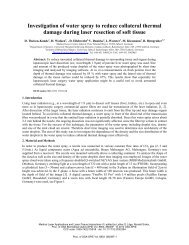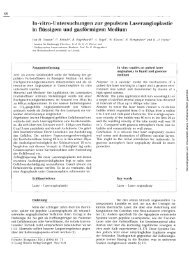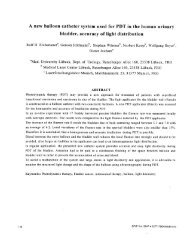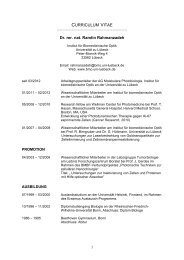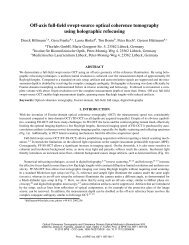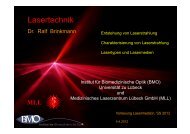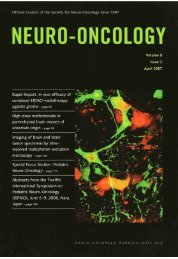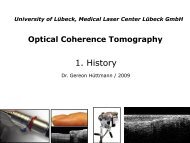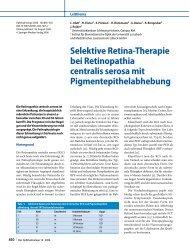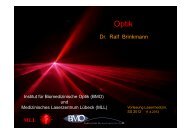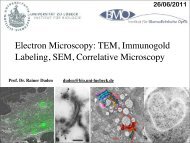Invited p aper Mechanisms of femtosecond laser nanosurgery of ...
Invited p aper Mechanisms of femtosecond laser nanosurgery of ...
Invited p aper Mechanisms of femtosecond laser nanosurgery of ...
Create successful ePaper yourself
Turn your PDF publications into a flip-book with our unique Google optimized e-Paper software.
VOGEL et al. <strong>Mechanisms</strong> <strong>of</strong> <strong>femtosecond</strong> <strong>laser</strong> <strong>nanosurgery</strong> <strong>of</strong> cells and tissues 1041ond or microsecond range [57, 213]. The bubble-nucleationthreshold by thermolysis <strong>of</strong> strongly absorbing biomoleculessuch as melanin was found to be about 150 ◦ C for pulse durationsbetween 12 ns and 1.8 µs [208]. This seems to be thelower temperature limit <strong>of</strong> cell surgery using microsecondpulses. The upper limit <strong>of</strong> a localized temperature rise withoutbubble formation is given by the threshold for explosive vaporizationin the entire focal volume that for non-pigmentedcells was found to be about 220 ◦ C [213]. This thresholdis lower than the superheat limit <strong>of</strong> water at ambient pressure(≈ 300 ◦ C) above which homogeneous nucleation andspinodal decomposition will result in a phase explosion [2,159, 163], probably because <strong>of</strong> the heterogeneous structure <strong>of</strong>the cells.The temperatures required for quasi-cw cell surgery areconsiderably higher than those involved in <strong>femtosecond</strong> <strong>laser</strong>dissection by high-repetition-rate fs pulse trains that relies onphotochemical and free-electron-mediated chemical effects(Sect. 7.1). They are in a similar range as the temperaturesneeded for <strong>femtosecond</strong> <strong>laser</strong> surgery at repetition rates below1MHzthat is based on bubble formation by tensile thermoelasticstress (Sect. 7.2).The spatial resolution <strong>of</strong> quasi-cw cell surgery is relatedto the temperature distribution arising from a continuous deposition<strong>of</strong> <strong>laser</strong> energy via linear absorption that was presentedin Fig. 11. Interestingly, it is not much broader than thetemperature distribution arising from nonlinear absorption <strong>of</strong><strong>femtosecond</strong> pulse trains shown in Fig. 10. However, as thespatial resolution <strong>of</strong> <strong>femtosecond</strong> <strong>laser</strong> surgery is given by thewidth <strong>of</strong> the free-electron distribution rather than by the temperaturedistribution, the precision <strong>of</strong> the energy depositionin fs <strong>laser</strong> surgery is considerably better than for cw or longpulsedirradiation. The half-width <strong>of</strong> the free-electron distributionshown in Fig. 8b for λ = 800 nm and NA = 1.3 is only190 nm in the radial direction, compared to the half-widths <strong>of</strong>590 nm and 730 nm <strong>of</strong> the temperature distributions in Fig. 11resulting from irradiation with pulse durations <strong>of</strong> 10 µs and10 ms, respectively. It should be mentioned, however, thatthermal damage is not directly proportional to the temperatureelevation but to the damage integral that is an exponentialfunction <strong>of</strong> temperature [212]. The thermally damaged regioncan therefore be narrower than the half-width <strong>of</strong> the temperaturedistribution [42, 214]. Because <strong>of</strong> this reason, the gain <strong>of</strong>spatial resolution achievable by use <strong>of</strong> ultra-short <strong>laser</strong> pulsesinstead <strong>of</strong> quasi-cw irradiation is less than <strong>of</strong>ten assumed.Using fs pulses, extracellular chromosomes could be completelydissected with an FWHM cut size <strong>of</strong> about 300 nm,which amounts to 40% <strong>of</strong> the diffraction-limited focal spotsize [37]. Berns et al. produced chromosomal lesions <strong>of</strong> lessthan 1-µm size using argon-<strong>laser</strong> irradiation [34]. Thus, thespatial resolution achieved by IR <strong>femtosecond</strong> <strong>laser</strong> surgeryis a factor <strong>of</strong> about three better than that <strong>of</strong> the classical techniqueintroduced more than 30 years ago [69].A major advantage <strong>of</strong> <strong>femtosecond</strong> <strong>laser</strong> surgery is thatit can be performed at arbitrary locations even in media thatare transparent at low irradiances, and with much less averagepower. The use <strong>of</strong> low-power argon <strong>laser</strong>s requires staining<strong>of</strong> the target structures [34, 47, 52, 69]. The need for stainingreduces the versatility <strong>of</strong> the technique compared to <strong>femtosecond</strong><strong>laser</strong> surgery that can be performed at any arbitrarylocation. Another important advantage <strong>of</strong> ultra-short <strong>laser</strong> irradiationis the option to combine material modification withhigh-resolution nonlinear imaging modalities.Recently, Paterson et al. reported that cell-wall permeabilizationis possible with a low-power blue diode <strong>laser</strong>(λ = 405 nm) using0.3-mW irradiation and 40-ms exposuretime [56]. Owing to the short <strong>laser</strong> wavelength, the energyused (13 µJ) was three orders <strong>of</strong> magnitude less than the energyrequired for membrane permeabilization with 488-nmirradiation [52]. It was more than one order <strong>of</strong> magnitudelarger than the energy <strong>of</strong> 0.5 µJ needed with ns pulses [48],but the transfection process with millisecond pulses avoidsmechanical disruptions extending beyond the region <strong>of</strong> the<strong>laser</strong> focus that are a problem with ns pulses [3]. Mechanicaldisruption was also avoided in the study by Tirlapur andKönig who used 80-MHz <strong>femtosecond</strong> pulse trains <strong>of</strong> 800 nmfor membrane permeabilization [53], but the total energy employedwas here about 50 times larger than with the blue diode<strong>laser</strong>. Considering the fact that a blue <strong>laser</strong> diode is less costlythan a <strong>femtosecond</strong> <strong>laser</strong>, the practical advantages <strong>of</strong> ultrashort<strong>laser</strong> pulses for membrane permeabilization still haveto be proven. However, ultra-short <strong>laser</strong> pulses are the tool<strong>of</strong> choice for intracellular and intratissue <strong>nanosurgery</strong> at arbitrarylocations and/or in conjunction with nonlinear imaging.7.4 Potential hazards from low-density plasmasin multiphoton microscopyand second-harmonic imagingA matter <strong>of</strong> concern is that low-density plasmascould be a potential hazard in multiphoton microscopy [203,210, 215–217] and higher-harmonic imaging [86, 218–221].Multiphoton imaging <strong>of</strong> cells is usually done using <strong>femtosecond</strong><strong>laser</strong> pulses <strong>of</strong> about 700–1100-nm wavelength emitted at≈ 80 MHz from an oscillator with mean powers <strong>of</strong> 100 µW upto several milliwatts [210, 211]. Similar mean powers are requiredfor second-harmonic imaging [220]. These <strong>laser</strong> powersare close to the threshold for cell damage reported to bebetween 2mW and 10 mW depending on the damage criterionused, the pulse duration, and the number <strong>of</strong> appliedpulses [4, 82, 98, 144, 202, 203]. They are also close to thevalues used for intracellular and intratissue dissection thatrange from 4 to 100 mW, depending on target structure [4,53, 55, 77, 86, 88]. This suggests that the mechanisms underlying<strong>laser</strong> cell surgery may also contribute to the side effectsin nonlinear imaging.Our results indicate that thermal damage can be ruledout as a cause <strong>of</strong> cell damage in multiphoton microscopy aseven dissection with oscillator pulses does not involve thermaleffects (Fig. 21), and previous studies confirm this finding[222, 223]. In the literature, photodamage produced byshort <strong>laser</strong> pulses is mostly ascribed to multiphoton-inducedphotochemistry [72, 82, 224]. However, a comparison <strong>of</strong> theirradiance thresholds for photodamage with the correspondingfree-electron densities in Fig. 21 shows that the formation<strong>of</strong> low-density plasmas may contribute considerably tothe observed damage or even dominate its creation, especiallyin non-stained targets. An exception is the work <strong>of</strong>Berns et al. [224], who achieved gene manipulation by exposingchromosomes that were sensitized with a dye absorbing



